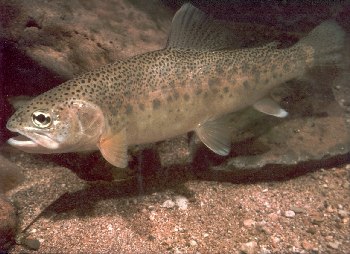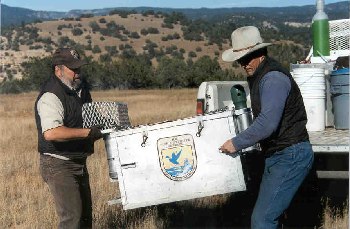Native Trout Conservation Pays Dividends
by Craig
Springer, U.S. Fish & Wildlife Service |
Click
Here to read
more "Fish Tails" |
It's hotter than a firecracker. Dusty and dry. The
sun's nearly straight up, beating right down on my balding head. Doesn't
seem like trout country in the Gila. Too hot. A jay skirts the ground,
alights in a pine and squawks at me, making me feel like an intruder.
I've worked my bones to get to this place in the wilderness, a few miles
in from my truck. My knees are numb, the joints feel like melted cheese.
But my elbow's loose for casting a short three-weight rod; my
enthusiasm's stuck in overdrive.
Trout fishing is at once an illness and elixir. Why
else punish my body to tussle with little copper-colored fish in a
far-off canyon?
The canyon is deep, parts of the creek bottom dark and
shaded, save for a spattering of yellow sunlight that slips through the
ponderosa pines and brittle streamside alders that keep the creek cool.
That's where the trout lie, in the shaded waters, pools scoured by water
pouring over downed boles. It's a little stream, and it's hard to hide
from the Gila trout who know a terrestrial predator when they see one.
Riparian ribbons are among the finest of edges in nature, but stalking
here is difficult, stealth nearly impossible save for lying on my belly.
The coppery flashes of startled trout seeking cover are evidence that
I'm too noisy and too big to hide. It takes some work; a bow cast
delivers a tiny dry fly onto a riffle. It bounces over the rocks and
streams into a glassy glide and wafts in a slow circular motion.
Then it happens. A Gila trout sips the offering off
the surface and at once knows it's been outwitted. That's the reward of
persistence and determination, first, to arrive at this wild place, and
second, to try to think like a fish. It's a scene that's played out time
and again, but only in the wild places of my mind.
The Gila trout is off limits to fishing, and has been
since before I was born. It's an endangered species, the only endangered
trout in the U.S. Not since 1958 have anglers been allowed to fish for
these copper trout, denizens of the Gila River headwaters.
But persistence and determination pay off in
conservation, too. Biologists from the U.S. Fish & Wildlife Service, the
New Mexico and Arizona game and fish departments, and the Forest Service
have worked diligently over the years to improve this trout's lot in
life. The Gila trout could soon be down-listed to 'threatened,' and with
that will come the real opportunity to go fish, perhaps as soon as
spring 2004.
The Gila trout is native only to the upper reaches of
the Gila River in New Mexico and Verde River in Arizona. Biologists
estimate that the trout originally occupied about 600 miles of streams.
At its absolute worst condition, Gila trout retreated to about 20 stream
miles from habitat loss and competition with non-native fishes. The good
news is, today they occupy 60 miles, and scientists reason that that's
enough for the improved conservation status.
 |
Gila Trout Credit
Courtesy Bill Roston |
Fishing will be a reward, the dividends of
conservation. And dividends will be paid elsewhere, if two other
native trout are any example. Greenback cutthroat trout, native to
the Rocky Mountains of Colorado once looked grimly at extinction.
Aggressive conservation efforts by the USFWS, Colorado Division of
Wildlife, and National Park Service, moved the fish from just
three small endangered populations in the early 1970's, to a
threatened species, with a serious following of ardent anglers.
This cutthroat trout provides a premier destination fishery, the
kind you read about in sporting magazines.
The Apache trout in eastern Arizona faced a similar
fortune. Today, anglers travel from well beyond the Southwest to fish
for these lemon-yellow trout. The White Mountain Apache Tribe, whose
land the Apache trout mostly occurs on, and neighboring towns benefit
from expenditures made by visiting anglers. The money spent by people
who enjoy catching native trout in native habitats puts people to work.
As with both of these rare trout, I'm convinced the
same will happen with Gila trout. Anglers will buy essential gear;
they'll spend their money in hotels; they'll eat at restaurants and buy
gas. Some will pay for guide services - a new market segment will open
up for these important locally owned businesses. Money changing hands in
the pursuit of a copper-colored trout will feed families.
The numbers bear this out, and the numbers are
staggering. According to the USFWS's 2001 national survey of fishing,
hunting and wildlife-associated recreation, angling reels in big bucks
in New Mexico. Some 314,000 people bought fishing licenses in New
Mexico, laying down $175 million for their piscatorial pursuits. More
than $90 million went toward travel, food, and lodging. Another $77
million went for rods and reels, waders and boats. Magazine
subscriptions, membership dues, land leases and fees accounted for
another $8 million. Across the nation, 34 million licensed anglers spent
nearly $36 billion in 2001, about $1,000 per angler.
Fishing is big business. And when the Gila trout moves
from endangered to threatened, I expect the benefits will ripple through
the economy like a dry fly landing on a glassy glide. Conservation
success will be measured in cash registers and pocket books, and even
county treasuries.
Angling's great apostle, Izaak Walton, wrote three
centuries ago that "angling will prove to be so pleasant that it will
prove to be like virtue, a reward unto itself."
He was right. I've caught greenback cutthroat and
Apache trout, and I hope to be among the many that will angle for Gila
trout when the time comes. And though I might purposely labor for
aloneness in the experience, the rewards will be shared in legal tender.
 |
Bob David (l), Alchesay-Williams Creek NFH,
and Jim Brooks, New Mexico
FRO, ready an oxygenated tank to carry endangered Gila trout from
Mora Fish
Technology Center into the wild via helicopter. Craig Springer/USFWS
photo
|
All content and photos © 2003 by
Craig Springer and other credited photographers
Resources:
-
 Click
here to buy maps and guidebooks to aid you in
your Wyoming flyfishing journeys Click
here to buy maps and guidebooks to aid you in
your Wyoming flyfishing journeys
All content and photos � 2003
by Craig Springer and other credited photographers
|